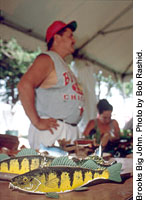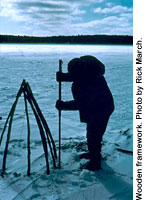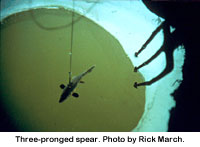|
Home | Search | The Artists | Teaching | Hiring | About This Site | Contact Us |
||||||||||

Ojibwe Fish Decoys
Brooks’ dad taught him how to ice fish when he was a boy, so he has a lot of experience. First Brooks packs all his fishing gear on a sled. Then he scouts out a good location where muskies or pike are likely to be prowling for smaller fish to eat. They like to hide in weed beds near the shore and dart out to catch unwary prey. After he finds a good spot, Brooks clears the snow off the ice in the shape of a big circle. The first big job is to make a round hole in the ice. The old way of doing this is to use an ice chisel mounted on a long handle of heavy pipe. This can be a lot of work. Often the ice is 16 or 18 inches thick. Today, Brooks may use a power ice auger. After Brooks drills the hole, he lays down pine boughs on the ice around the hole and covers them with a tarp. The pine boughs create insulation between Brooks’ body and the ice. He doesn’t want his body heat to melt the ice and get his clothes wet. Brooks uses tobacco to give thanks in advance of catching a fish. He sprinkles a little into the hole to show his appreciation for all the good things and the help the Creator gives to him. Brooks offers a prayer of gratitude too while he sprinkles the tobacco as a gift.
Brooks crawls inside the dark teepee. He lays on his chest, so he can see clearly through the hole into the water. Sunrays that hit the iced lake illuminate the water. Brooks says the hole in the ice is like “a window into another world.”
Brooks ties the cord attached to the spear’s handle to the frame of the teepee. He gets out a fishing decoy and jigs for fish. Watch out, muskies! Making wooden decoys and setting up spear fishing teepees is an Ojibwe art and tradition. Listen to Big John talk about how he ice fishes. You can read along by clicking here. Learn More! The six Ojibwe tribes in Wisconsin all spear fish. To find out more about each tribe and their location, go to Resources for Students and click on the Great Lake’s Intertribal Council link. Really into fish? You can find Wisconsin fish profiles and more about the history of Ojibwe ice fishing on the resources page too. |
For Educators: |
|||||||||
|
“We have a twelve by twelve square mile reservation in Lac du Flambeau and 126 lakes on our reservation, so fishing was only natural.” – Brooks Big John |
||||||||||
|
Home | Search | The Artists | Teaching | Hiring | About This Site | Contact Us |
||||||||||

 The Ojibwe have been in the
The Ojibwe have been in the
 Next, Brooks puts up the wooden framework of his ice fishing teepee. It is
about three or four feet high. He drapes tarps, blankets or old sleeping bags over the frame. They have to be thick enough to block the sunlight from getting through.
Next, Brooks puts up the wooden framework of his ice fishing teepee. It is
about three or four feet high. He drapes tarps, blankets or old sleeping bags over the frame. They have to be thick enough to block the sunlight from getting through. Now Brooks has to get his fishing equipment ready. He has a three-pronged spear
made from a pitchfork. Barbs on the ends of the spear’s points will hold the fish on the spear. The pipe handle had melted lead poured into it so that it is heavy and will thrust quickly into the
water.
Now Brooks has to get his fishing equipment ready. He has a three-pronged spear
made from a pitchfork. Barbs on the ends of the spear’s points will hold the fish on the spear. The pipe handle had melted lead poured into it so that it is heavy and will thrust quickly into the
water.